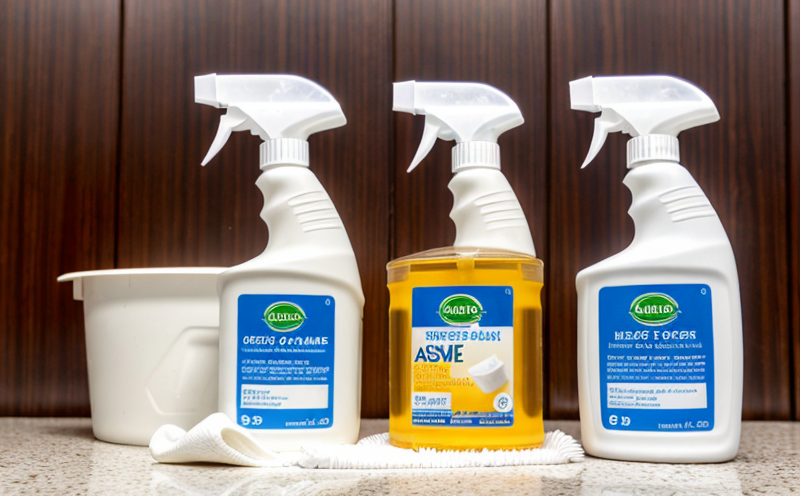IEC 62961 Antimicrobial Coating Testing in Cleaning Appliances
The International Electrotechnical Commission (IEC) has established standard IEC 62961:2013
This standard provides a framework for the testing and evaluation of antimicrobial coatings used on cleaning appliances. The primary objective is to ensure that these products are effective in reducing microbial contamination, thereby enhancing hygiene and safety standards.
The standard covers various aspects including:
- Test methods for determining the efficacy of antimicrobial coatings
- Specimen preparation procedures
- Instrumentation used during testing
- Data analysis techniques for results interpretation
The focus is on cleaning appliances such as dishwashers, washing machines, and air purifiers. These appliances are critical in maintaining hygiene, especially in environments where cross-contamination can be a concern.
Testing under IEC 62961 involves multiple steps:
- Specimen Preparation: The cleaning appliance is prepared according to the standard's specified protocols. This ensures that the test conditions are consistent and replicable.
- Inoculation: Microbial cultures are introduced into the cleaned specimen to simulate real-world contamination scenarios.
- Treatment Application: Antimicrobial coatings are applied as per manufacturer specifications.
- Incubation Period: The treated specimens undergo an incubation period under controlled conditions. This allows for the growth and analysis of any remaining microorganisms.
- Data Collection & Analysis: Post-incubation, samples are analyzed using microbiological techniques to determine the reduction in microbial load. Results are compared against baseline data from untreated specimens.
IEC 62961 ensures that cleaning appliances meet stringent hygiene standards set by global health organizations like WHO and CDC. It is particularly relevant for sectors such as healthcare, hospitality, and residential settings where cleanliness and sanitation are paramount.
The standard's rigorous testing protocols help manufacturers demonstrate compliance with international standards, which in turn enhances market acceptance and consumer confidence.
International Acceptance and Recognition
IEC 62961 has gained widespread acceptance across the globe due to its stringent testing protocols. Many countries have adopted this standard as part of their regulatory framework for hygiene products. For instance, in the EU, this standard is recognized by the European Commission as a harmonized standard.
The international recognition of IEC 62961 ensures that manufacturers can easily comply with global standards and export their products to various markets without additional testing requirements. This reduces costs and accelerates market entry for companies adhering to these guidelines.
Recognizing the importance of this standard, many quality managers and compliance officers in sectors such as healthcare, hospitality, and residential settings have begun incorporating IEC 62961 into their procurement processes. By sourcing products that meet this standard, they ensure high hygiene standards across all their facilities.
Competitive Advantage and Market Impact
Adhering to the rigorous requirements of IEC 62961 can provide significant competitive advantages for manufacturers. In a highly regulated market where consumer trust is paramount, compliance with this standard can set products apart from competitors.
Companies that comply with IEC 62961 are able to offer products that have been independently verified as effective in reducing microbial contamination. This not only enhances product reputation but also opens up new markets for the manufacturer.
The standard's recognition by global bodies and its adoption in various countries means that manufacturers can leverage this compliance to gain a competitive edge. It ensures that their products meet international hygiene standards, thereby increasing market appeal and customer confidence.
Use Cases and Application Examples
| Application Scenario | Description |
|---|---|
| Hospital Laundry Systems | Demonstrates the effectiveness of antimicrobial coatings in reducing bacterial contamination in hospital laundry systems. |
| Luxury Hotels & Resorts | Ensures that guest rooms and public areas are maintained at high hygiene standards, enhancing the overall customer experience. |
| Residential Appliances | Guarantees the quality of cleaning appliances used in households, ensuring effective microbial reduction for improved hygiene. |
| Application Scenario | Description |
|---|---|
| Clinical Laboratories | Supports the use of high-quality equipment that ensures accurate and reliable test results in clinical settings. |
| Food Processing Plants | Maintains hygiene standards by ensuring that cleaning appliances are effective in eliminating pathogens, thus protecting food safety. |
| Beverage Manufacturing Facilities | Ensures the cleanliness of equipment used in beverage manufacturing processes to prevent contamination and ensure product integrity. |





